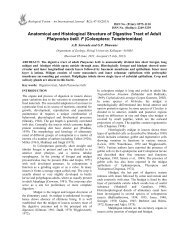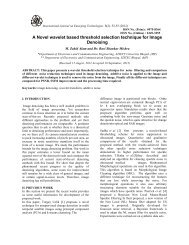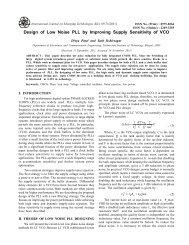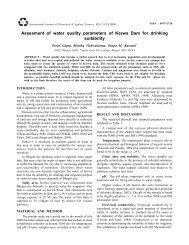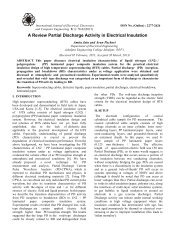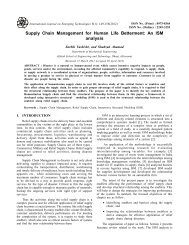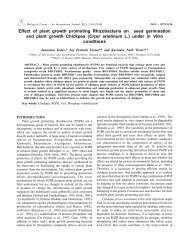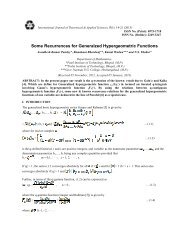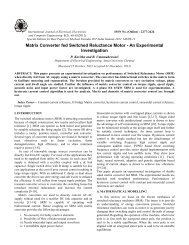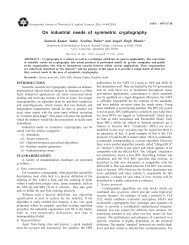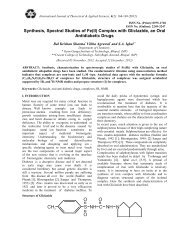Ichthyofaunal Diversity of Kulsi River - Researchtrend.net
Ichthyofaunal Diversity of Kulsi River - Researchtrend.net
Ichthyofaunal Diversity of Kulsi River - Researchtrend.net
Create successful ePaper yourself
Turn your PDF publications into a flip-book with our unique Google optimized e-Paper software.
Goswami and Ali 43<br />
6) Order: Siluriformes (5 families, 15spp)<br />
Family: Bagridae (6 spp)<br />
Rita rita (Hamilton, 1822)<br />
Aorichthys seenghala (Sykes, 1841)<br />
Sperata aor (Hamilton, 1822)<br />
Hemibagrus menoda (Hamilton, 1822)<br />
Mystus tengara (Hamilton, 1822)<br />
Mystus vittatus (Bloch , 1794)<br />
Family: Clariidae (2 spp)<br />
Clarias magur (Hamilton, 1822)<br />
Clarias magur (Common name: Thailand magur)<br />
Family: Schilbeidae (2 spp)<br />
Ailia coila (Hamilton, 1822)<br />
Clupisoma garua (Hamilton, 1822)<br />
Family: Siluridae (4 spp)<br />
Wallago attu (Bloch & J. G. Schneider, 1801)<br />
Ompok pabo (Hamilton, 1822)<br />
Ompok pabda (Hamilton, 1822)<br />
Ompok bimaculatus (Bloch , 1794)<br />
Family: Heteropneustedae (1 sp)<br />
Heteropneustus fossilis (Bloch , 1794)<br />
7) Order: Synbranchiformes (1 family, 3 spp)<br />
Family: Mastacembelidae (3 spp)<br />
Mastacembalus armatus armatus (Lacepède, 1800)<br />
Macrognathus aral (Bloch and Schneider, 1801)<br />
Amphipnous cuchia (Hamilton, 1822))<br />
8) Order: Tetradontiformes (1 family, 1sp)<br />
Family: Tetradontidae (1sp)<br />
Tetradon kutkutia (Hamilton, 1822).<br />
Channa punctatus (Bloch, 1792)<br />
Family: Cichlidae (1 sp)<br />
Oreochromis mossambica (Peters)<br />
Family: Gobiidae (1 sp)<br />
Glossogobius giuris (Hamilton, 1822)<br />
Family: Nandidae (1 sp)<br />
Nandus nandus (Hamilton, 1822)<br />
Family: Osphronemidae (1 sp)<br />
Ctenops nobilis (McClelland, 1845)<br />
Cypriniformes is the most dominant group<br />
throughout the river (29 species) and Cyprinidae is<br />
the most species rich family (26 species). Puntius<br />
sophore is the most dominant species in kukurmara<br />
and kulsi village whereas Wallago attu density is<br />
highest at nagarbera. Nagarbera harbor mainly large<br />
fishes, in turn in kukurmara small fish population is<br />
abundant.<br />
Effect <strong>of</strong> Anthropogenic stress on the river<br />
It is said that wetlands are more precious than trees to<br />
maintain global warming.<br />
These are the heart <strong>of</strong> rivers. <strong>Kulsi</strong> is surrounded by a<br />
number <strong>of</strong> wetlands viz. <strong>Kulsi</strong>, Dorabeel,<br />
Kukurmara, Salsola, Barpith, Baweli, Chandubi etc<br />
which are now at deteriorating state.<br />
The nearby fishers do some plantation like<br />
paddy, banana, areca-nuts, vegetables etc. to live life.<br />
As the neighboring area is a flood prone area hence<br />
paddy cultivation is not pr<strong>of</strong>itable. With the<br />
emergence <strong>of</strong> Chinese cultivation, problem is solved<br />
to some extent. But it affects the river. Again, one <strong>of</strong><br />
the characteristic features <strong>of</strong> the river is water level <strong>of</strong><br />
the river fluctuates depending mainly on rainfall in<br />
Meghalaya, not that <strong>of</strong> Assam.<br />
Moreover, another major anthropogenic<br />
stress is industrialization. Hand some <strong>of</strong> people set<br />
up industry in the nearby wetlands e.g. brick industry<br />
in kukurmara ghat, on dora beel about 200 bigha land<br />
is occupied to construct a distillery industry. This<br />
physical habitat loss/degradation is one <strong>of</strong> the threats<br />
to indigenous fish diversity.<br />
Heavy sand mining is also affecting the<br />
river resource a lot. In <strong>Kulsi</strong> <strong>River</strong>, as depth is low,<br />
hence sand mining up to a limit is necessary. But<br />
mining above threshold value stressed thereby<br />
population. Henceforth, it is beneficial and at the<br />
same time limiting factor for conservation and<br />
biodiversity.<br />
Other threats are over exploitation, siltation<br />
(God & Goddess <strong>of</strong> Durga puja are thrown in the<br />
<strong>Kulsi</strong> <strong>River</strong>), destruction <strong>of</strong> outlet (gumi -cut) etc.<br />
Moreover, other anthropogenic stresses are over<br />
fishing, entry <strong>of</strong> exotic species, ignorance <strong>of</strong><br />
fishermen etc. While the eco-tourism venture is<br />
gaining momentum at various potential sites <strong>of</strong> the<br />
fishes, in turn in kukurmara small fish population is<br />
abundant. This may be due to over fishing at<br />
kukurmara. Over fishing is also going on at<br />
nagarbera. But area <strong>of</strong> nagarbera is much larger in<br />
comparison to fishing community. Hence nagarbera<br />
is not affected. The highest numbers <strong>of</strong> varieties<br />
were obtained at Nagarbera (63 species). People <strong>of</strong><br />
Nagarbera also used maximum varieties <strong>of</strong> fishing<br />
gears. As the abundance <strong>of</strong> fish is high, hand<br />
pricking <strong>of</strong> fish is also done and proved as a fruitful<br />
method. Various <strong>net</strong>ting operation is done<br />
throughout the river. The main gears used are hook,<br />
line, <strong>net</strong> (Cast <strong>net</strong>, Gill <strong>net</strong> etc) Bamboo basket,<br />
Bamboo trap, duruk, dingora, chalani, etc. Nets are<br />
known among the local community as asra jal, lungi<br />
jal, jata jal, ghoka jal, mohori jal, boital, etc.



